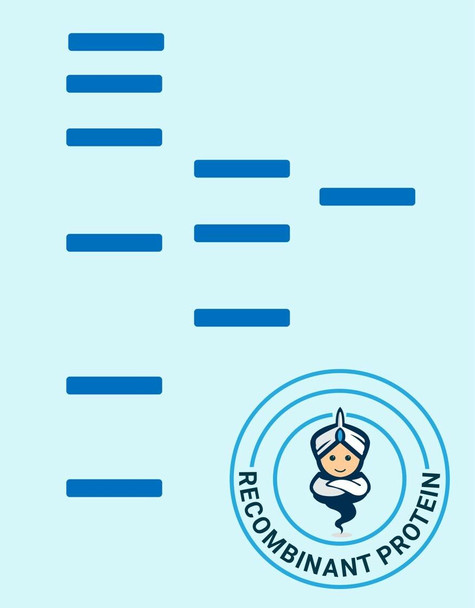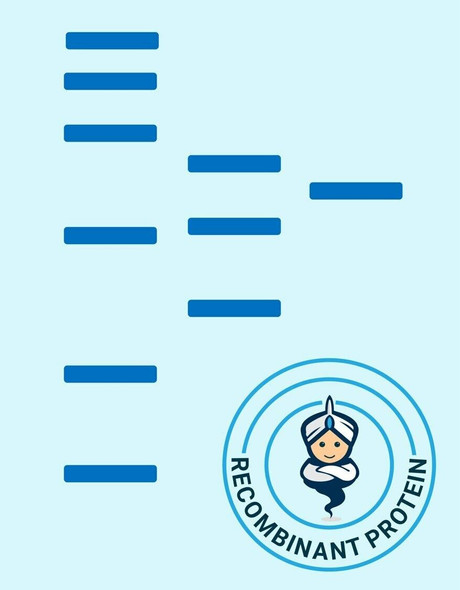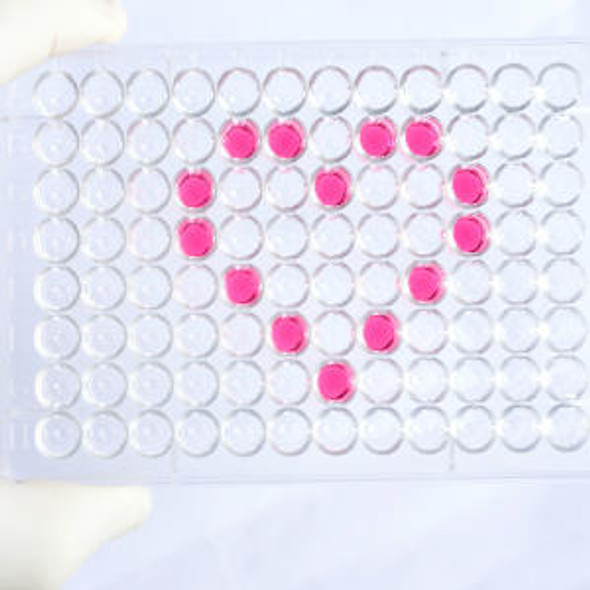Human ACVRL1 Recombinant Protein (RPPB0010)
- SKU:
- RPPB0010
- Product type:
- Recombinant Protein
- Size:
- 10ug
- Species:
- Human
- Target:
- ACVRL1
- Synonyms:
- Activin A Receptor Type II-Like 1
- ACVRLK1
- ALK1
- TGF-BSuperfamily Receptor Type I EC 271130
- Source:
- Sf9 Insect cells
- Uniprot:
- P37023
Description
| Product Name: | Human ACVRL1 Recombinant Protein |
| Product Code: | RPPB0010 |
| Size: | 10µg |
| Species: | Human |
| Target: | ACVRL1 |
| Synonyms: | Activin A Receptor Type II-Like 1, ACVRLK1, ALK1, TGF-BSuperfamily Receptor Type I EC 2.7.11.30, TSR-I, ALK-1, HHT2, SKR3Serine/Threonine-Protein Kinase Receptor R3 Activin A Receptor, TypeII-Like Kinase 1, Activin Receptor-Like Kinase 1, EC 2.7.11, ORW2, HHT. |
| Source: | Sf9 Insect cells |
| Physical Appearance: | Sterilefiltered colorless solution. |
| Formulation: | ACVRL1 protein solution (0.25mg/ml) contains phosphatebuffered saline (pH7.4) and 10% glycerol. |
| Stability: | Store at 4°C if entire vial will be used within 2-4 weeks.Store, frozen at -20°C for longer periods of time. For long term storage it is recommended to add a carrier protein (0.1% HSA or BSA).Avoid multiple freeze-thaw cycles. |
| Purity: | Greaterthan 95.0% as determined by SDS-PAGE. |
| Amino Acid Sequence: | DPVKPSRGPL VTCTCESPHC KGPTCRGAWC TVVLVREEGR HPQEHRGCGN LHRELCRGRP TEFVNHYCCD SHLCNHNVSL VLEATQPPSEQPGTDGQHHH HHH |
Activin A Receptor Type II-Like 1, also knownas ACVRL1 is a membrane-anchored proteoglycan which his core protein binds TGFf3 and has a shortcytoplasmic domain with no discernible signaling structure. Furthermore, ACVRL1 shares similar domain structures withother closely related ALK or activin receptor-like kinase proteins which form asubfamily of receptor serine/threonine kinases.
ACVRL1 produced in Sf9 Insect cells is a single, glycosylatedpolypeptide chain containing 103 amino acids (22-118a.a.) and having amolecular mass of 11.5kDa. (Molecular size on SDS-PAGE will appear atapproximately 18-28kDa).ACVRL1 is expressed with a 6 amino acid His tag atC-Terminus and purified by proprietary chromatographic techniques.
| UniProt Protein Function: | ALK1: a kinase of the STKR family. A type I cell-surface receptor for the TGF-beta superfamily of ligands including Activin A. Highly expressed in human placenta and lung. Deficiency causes hemorrhagic telangiectasia type 2 also known as Rendu-Osler-Weber syndrome 2. |
| UniProt Protein Details: | Protein type:EC 2.7.11.30; Kinase, protein; Membrane protein, integral; Protein kinase, Ser/Thr (receptor); Protein kinase, TKL; STKR family; TKL group; Type1 subfamily Chromosomal Location of Human Ortholog: 12q13.13 Cellular Component: cell surface; integral to plasma membrane; plasma membrane Molecular Function:activin binding; activin receptor activity, type I; ATP binding; protein binding; protein kinase binding; protein serine/threonine kinase activity; SMAD binding; transforming growth factor beta binding; transforming growth factor beta receptor activity; transforming growth factor beta receptor activity, type I Biological Process: angiogenesis; blood circulation; blood vessel endothelial cell proliferation during sprouting angiogenesis; blood vessel maturation; blood vessel remodeling; BMP signaling pathway; lymphangiogenesis; negative regulation of blood vessel endothelial cell migration; negative regulation of cell adhesion; negative regulation of cell growth; negative regulation of cell migration; negative regulation of cell proliferation; negative regulation of focal adhesion formation; positive regulation of BMP signaling pathway; positive regulation of chondrocyte differentiation; positive regulation of transcription from RNA polymerase II promoter; positive regulation of transcription, DNA-dependent; protein amino acid phosphorylation; regulation of blood pressure; regulation of blood vessel endothelial cell migration; regulation of DNA replication; regulation of endothelial cell proliferation; regulation of transcription, DNA-dependent; signal transduction; transforming growth factor beta receptor signaling pathway; wound healing, spreading of epidermal cells Disease: Telangiectasia, Hereditary Hemorrhagic, Type 2 |
| NCBI Summary: | This gene encodes a type I cell-surface receptor for the TGF-beta superfamily of ligands. It shares with other type I receptors a high degree of similarity in serine-threonine kinase subdomains, a glycine- and serine-rich region (called the GS domain) preceding the kinase domain, and a short C-terminal tail. The encoded protein, sometimes termed ALK1, shares similar domain structures with other closely related ALK or activin receptor-like kinase proteins that form a subfamily of receptor serine/threonine kinases. Mutations in this gene are associated with hemorrhagic telangiectasia type 2, also known as Rendu-Osler-Weber syndrome 2. [provided by RefSeq, Jul 2008] |
| UniProt Code: | P37023 |
| NCBI GenInfo Identifier: | 3915750 |
| NCBI Gene ID: | 94 |
| NCBI Accession: | P37023.2 |
| UniProt Secondary Accession: | P37023,A6NGA8, |
| UniProt Related Accession: | P37023 |
| Molecular Weight: | 56,124 Da |
| NCBI Full Name: | Serine/threonine-protein kinase receptor R3 |
| NCBI Synonym Full Names: | activin A receptor like type 1 |
| NCBI Official Symbol: | ACVRL1 |
| NCBI Official Synonym Symbols: | HHT; ALK1; HHT2; ORW2; SKR3; ALK-1; TSR-I; ACVRLK1 |
| NCBI Protein Information: | serine/threonine-protein kinase receptor R3 |
| UniProt Protein Name: | Serine/threonine-protein kinase receptor R3 |
| UniProt Synonym Protein Names: | Activin receptor-like kinase 1; ALK-1; TGF-B superfamily receptor type I; TSR-I |
| Protein Family: | Serine/threonine-protein kinase haspin |
| UniProt Gene Name: | ACVRL1 |










